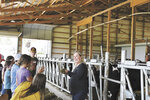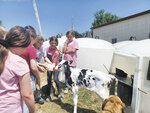

KELLOGG, Minn. — On a sunshiny May afternoon, Miller Broz. Dairy is buzzing with activity. Kids sit in the wheel well of a parked tractor, a young girl wraps her arms around a big, patient Red and White Holstein cow and other youngsters make friends with the calves.
The children are fourth-grade students at Wabasha-Kellogg School District where Brianna (Miller) Baab is a teacher. Baab brought her students and the rest of the fourth grade on a field trip to visit her home dairy farm.
Miller Broz. Dairy consists of Baab’s parents, Tom and Kay Miller, as well as her twin brother, Bryton Miller, and his wife, Morgan Miller, who farm alongside but separately from their parents. Together, the Millers milk 240 cows on the same property near Kellogg with four Lely robotic milking units, which they began using in January.
Other members of the family — including Austin Baab, Dalon Miller, Carley Miller, Talia Miller and Terrik Miller — are involved on the dairy as well during high labor times such as forage harvest. Tagen Miller has assisted full time in the past but is stepping back now that the farm is adjusting to the robotic milking units.
This was the first time the Millers hosted a school visit.
“We wanted them to go home and talk to their families about how exciting it was to see the calves and pet the cow,” Kay said. “(We want them to) spread the word and let ... other people enjoy it through them.”
This year, Bryton said their new barn was something different and exciting for the kids to see.
“(We wanted) to get kids out on the farm and show them what it’s all about and where their milk is coming from,” Bryton said.
The Miller farm was the second stop of the day for the school group. In the morning, they visited Jeremy Holst’s dairy farm near Lake City. Holst milks in a parlor, which gave the students an opportunity to see two different milking systems.
Tom talked about how far removed this generation is from dairy farming.
“When we grew up, everybody grew up on a farm or their grandma and grandpa had a farm,” Tom said. “Most of these (kids) have never been on a farm.”
The kids were split up into four groups to explore four immersive stations.
The first station had a New Holland TG275 tractor where students could take turns sitting in the driver’s seat. The next area held the calves, where students could try bottle feeding. Near the barn, a nutrition consultant, Barloe Brisson Kanz, showed the students the total mixed ration and talked about other aspects of the diet.
The fourth location focused on equipment. Students toured the farm office to look at data on the computer, watched cows being milked from the robot room, and then had a chance to climb up on the bulk tank and look inside.
Students finished the day with a snack and a glass of milk.
The robotic dairy barn the students toured is a recent addition for the Millers. Their first day milking cows in the facility was Jan. 2. The transition to the new robotic setup has been quick.
“Never in my wildest imagination did I think it was going to turn out this nice and be running like this at this point,” Tom said.
Bryton agreed.
“We thought it’d take like two to three years to get to where we’re at,” Bryton said.
The update included a new freestall barn with the robotic milking units and a lagoon with a storage capacity of nine months.
The project was not an expansion. The barn has two sides, one for Tom and Kay’s cows and one for Bryton and Morgan’s.
“It’s not about getting bigger; it was just (about) maintaining it as a family dairy,” Kay said.
The family broke ground for the project in June 2023, the day Bryton and Morgan were married.
“It was hard to leave here to go to my wedding, knowing that this project was starting,” Bryton said.
The Millers poured the cement for the barn themselves. This was the first time the Millers had done a cement project of this magnitude, Tom said. In all, they poured about 863 yards of cement. They even had to form cement by the headlight of their utility terrain vehicle to get the project done.
The decision to update came because their freestall barns were worn out and it was difficult to find help to milk in the parlor. With the new facility, the Millers have eliminated outside labor.
“We still work ... just as hard as we did before,” Tom said. “The times are more flexible (now), and we’re not as tied down.”
Tom said when they had employees in the past, they dealt with employees only showing up when they felt like it.
During the transition, the Millers said, they appreciated the help of friends and neighbors pushing cows through the robotic milking units.
The cows average 2.9 visits to the robots per day and give 82 pounds of milk. Before switching to the robotic milking units, the Millers milked their cows twice a day. With the additional milking, the Millers increased production by about 8-10 pounds of milk per cow.
The Millers said they have seen a change in the demeanor of their cows, which have become friendlier.
“They sleep when they want, they eat when they want and they get milked when they want,” Tom said.
The Millers are content with the project Kay said.
“(We are) 100% happy,” she said. “There are challenges and there’s still a lot of work involved in it, but it is absolutely the right thing for us.”
Comments
No comments on this item Please log in to comment by clicking here